For marketers today, website analytics make up a significant portion of how they measure and report on website and other campaign performance. Those traditional web analytics—such as the kind Google Analytics and similar tools offer—can tell you a lot about the numbers behind a website: how many people visited this page, how long they stayed, where they came from, and more.
But they can’t tell you much about the visitors to that website, including:
What company are they coming from
Who came back to the site again and when
Which pages did each company visit, etc.
And for B2B marketers, getting to know your website visitors and their behavior on your site is a must. That’s where visitor analytics comes in.
Traditional website analytics tools show you a lot of data, but it’s all anonymized. It’s disconnected from the person or company actually visiting your site. Visitor analytics, on the other hand, enables B2B marketers to make that connection and better understand website visitors and their behavior.
In this article, we share:
More details on what visitor analytics can tell you about your website and visitors.
How we approach visitor analytics at Leadfeeder.
A walk-through of how our visitor analytics software works.
Three examples of visitor analytics data in action.
Note: Looking for more in-depth data on the companies behind your web analytics? Sign up and try Leadfeeder free for 14 days to see who’s visiting, the pages they’re looking at, and more.
What Visitor Analytics Can Tell You
There are three main categories of information that visitor analytics data can shed light on:
Who is visiting your website
Where they’re coming from (including referrers)
The pages they visit and what they do while there.
While you can get anonymized site statistics that tell you a piece of the story on those last two, gaining access to that who piece opens up a whole new way to understand and measure B2B marketing performance.
For example, Google Analytics can tell you that the bounce rate on your signup page is 30%. Visitor analytics can tell you which companies fall into that 30%.
Google Analytics can tell you that your conversion rate is 2%. Visitor analytics can tell you which companies visited and didn’t convert.
Visitor analytics tools can also give you more details about those companies (like company size, industry, etc.), plus the pages they visited before bouncing off the signup page, how long they spent on your website before bouncing, and more.
In short, visitor analytics enables you to put a face (or a logo) to your website data and to connect multiple visits from the same returning visitor.
How Leadfeeder Approaches B2B Visitor Analytics
Here at Leadfeeder, we’re all about helping companies make the connection between website data and the faces behind it. But when we built our product, we realized that B2B marketers don’t need a face—they need a logo. They don’t need website analytics—they need visitor analytics.
Because for B2B companies, knowing which companies visit your website is more important than identifying the individual people. (It also makes it easier to stay GDPR-compliant, too.)
For one, identifying website page views by company enables you to connect all the different people, within one target account, who visit your website. Account-level visitor identification also opens the door to account-based marketing and, more specifically, account-based retargeting ads—something that’s basically impossible without identifying the companies that visit your site.
With that in mind, we built several features into our visitor analytics software that are designed to help B2B marketers more effectively measure website performance, optimize marketing efforts to target the right accounts, and work together with the sales team:
Custom Feeds: Our Custom Feeds enable marketers and sales reps alike to filter website visitors based on key data about the companies visiting. For example, you can create a feed that shows visitor analytics for companies from the U.S., that work in software, and have more than 1000 employees.
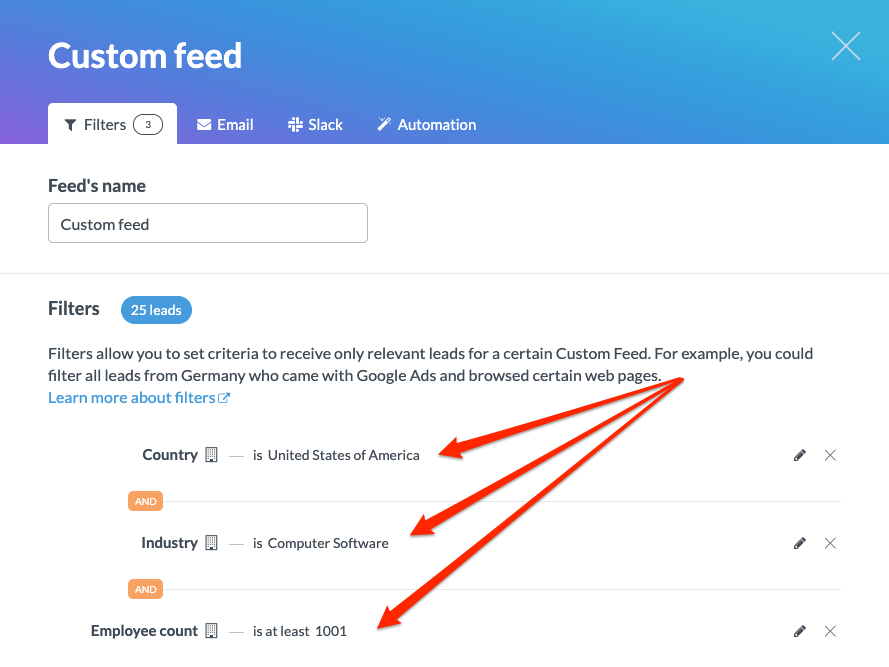
Integrations: There are a lot of ways to use visitor analytics data, so we’ve built more than a dozen integrations and plugins with data visualization tools, CRMs, internal communication tools, and more—to make it easier to use your visitor analytics data for things like reporting, lead generation and lead scoring, and more.
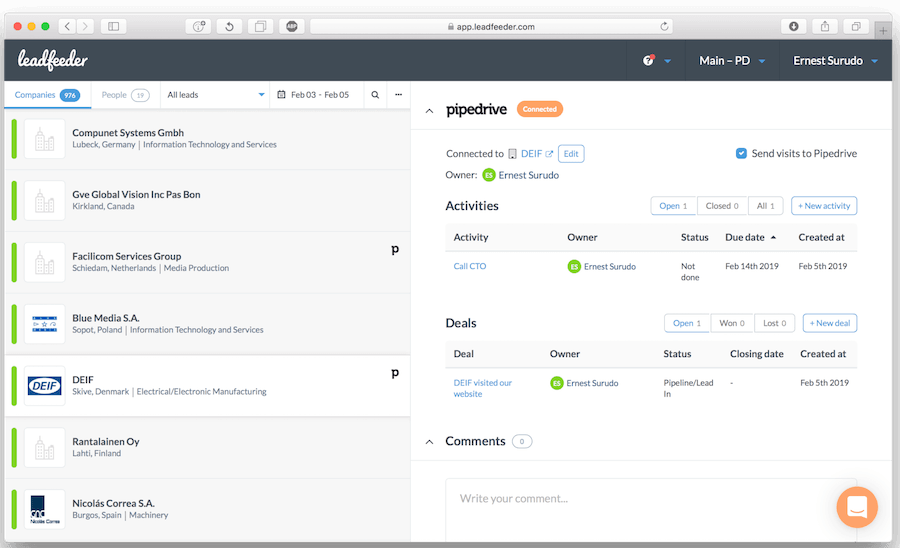
Automation: The easier it is to capitalize on visitor analytics data, the more useful it can be. That’s why we built automations into our Custom Feeds. When you create a feed, you can set it to automatically send new leads to a particular Slack channel, for example, or tag the company as a highly qualified lead. You can also set automations to assign new leads to a particular sales rep.
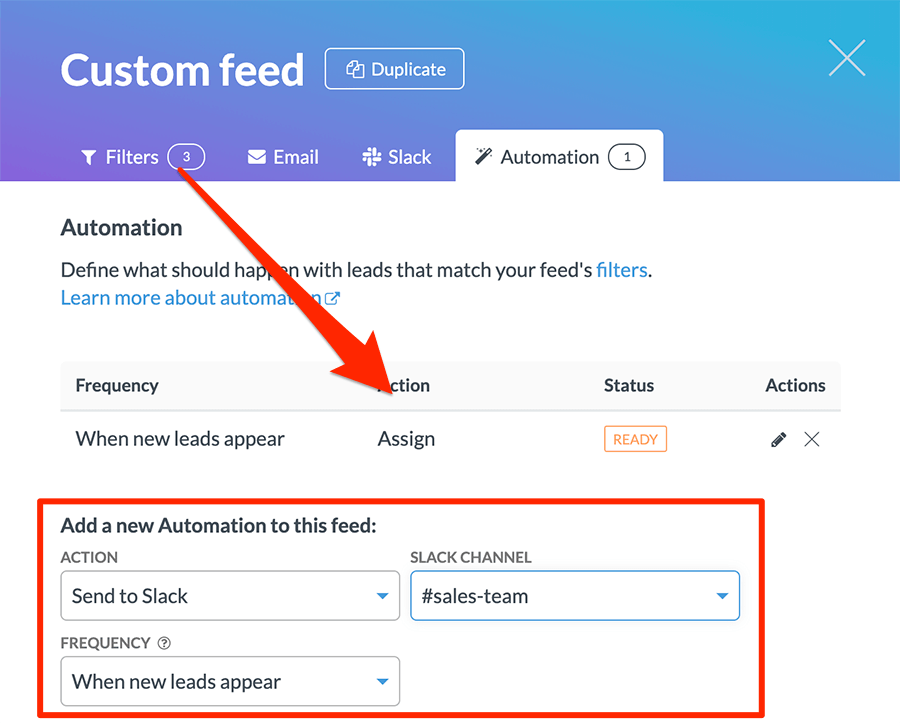
Note: Looking for more than Google Analytics’ anonymized data? Sign up and try Leadfeeder free for 14 days to the companies behind your website analytics.
How Our Visitor Analytics Tool Works
Here’s a quick look at how our visitor analytics tool works to augment the data available in Google Analytics by enabling marketers to:
Identify the companies visiting your site
Learn more about each one
Understand their interest and buying intent signals
Filter companies to find your best leads and the marketing efforts that drove them to your site.
Note: We showcase all of this and more, step-by-step, in a prior blog post on how one B2B content marketing agency uses Leadfeeder to gauge the quality of traffic and leads their content generates. You can find the full walk-through here.
See the Companies That Visit Your Website
When you first log into Leadfeeder, you’ll see the “All Leads” report (shown in the screenshot below).

This feed shows you all the companies that have visited your website, and it’s sorted by how engaged a company is with your site.
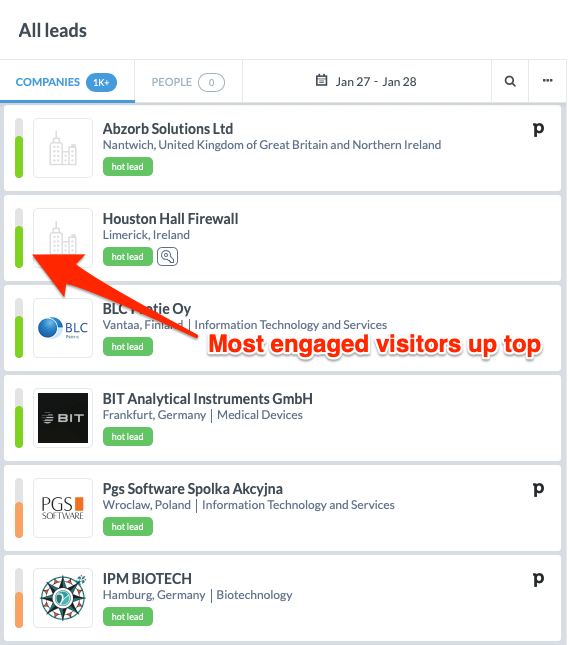
Engagement is represented by green, orange, and red indicators.
With that information alone, you can identify new marketing qualified leads (MQLs) and help the sales team prioritize existing leads.
Learn About the Companies Visiting Your Site
From there, you can click into each of the companies to view more details about the company, including:
A brief description
Industry
Company size (by employee count)
Location
Contacts within the company.
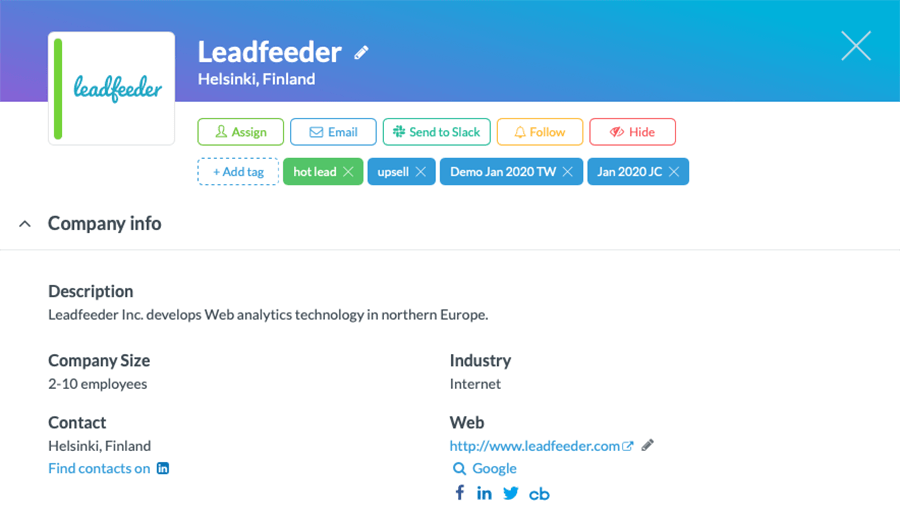
That data enables marketing and sales to further qualify potential leads that have visited your website, and it gives sales reps a starting point for finding decision-makers and initiating outreach.
Understand What Companies and Leads Are Interested In
Below that, you can get behavioral details about what they’ve been looking at on your website. Those details (shown in the screenshot below) include:
Page(s) visited
Total session duration and time on each page
Source of the visit
How many individuals from the company visited your website.
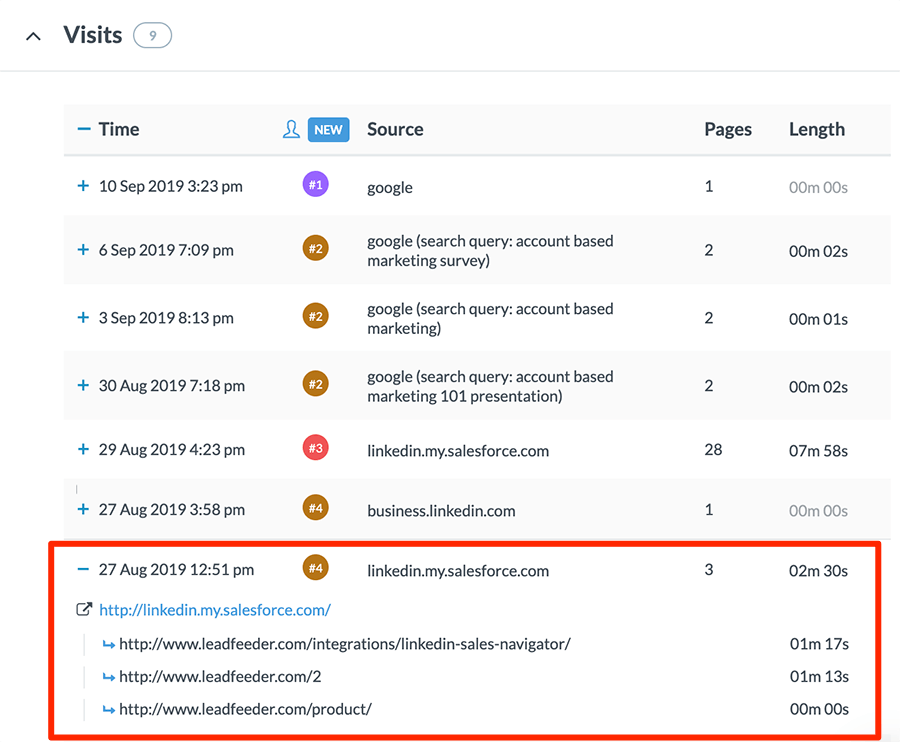
Colored circles identify visit data by the 1st, 2nd, 3rd, and 4th people from the company to visit your site.
Behavioral visit data helps you get a better sense of how engaged individual companies visiting your website are. It also enables you to identify areas of interest that can help make your marketing nurture campaigns and sales outreach more personalized and targeted.
Filter Companies by Engagement, Source, and More
The next step is to break that information down using the Custom Feeds feature we highlighted above.
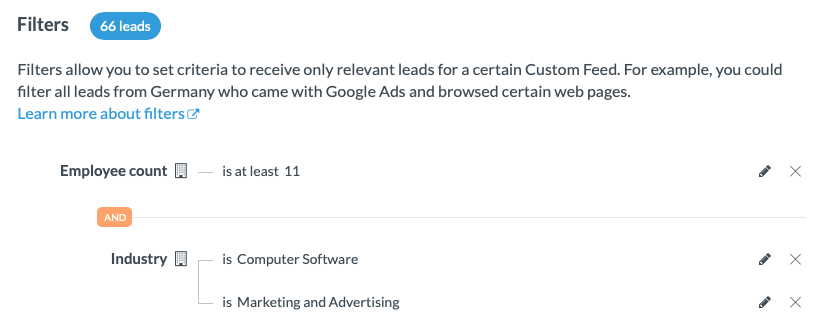
For example, you can create a Custom Feed to show you the companies that spend a certain amount of time on your website:
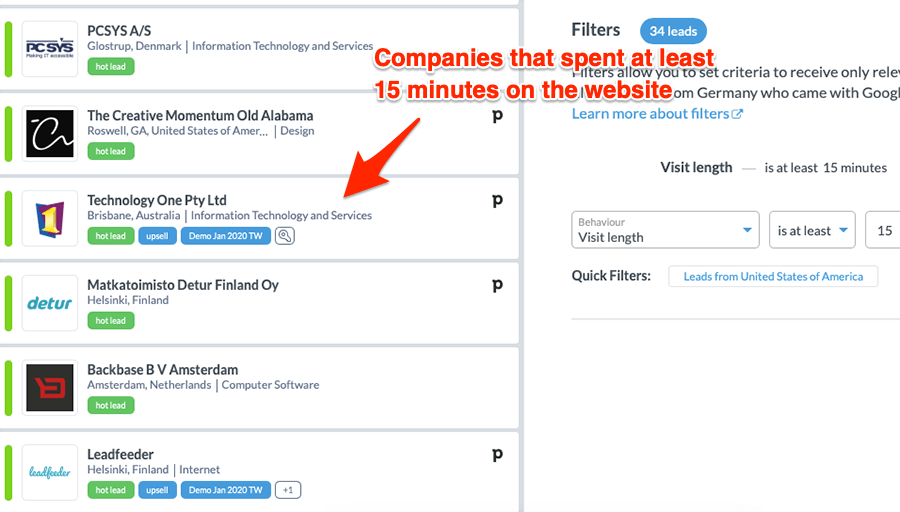
You can also break out companies by the source that led them to your site:
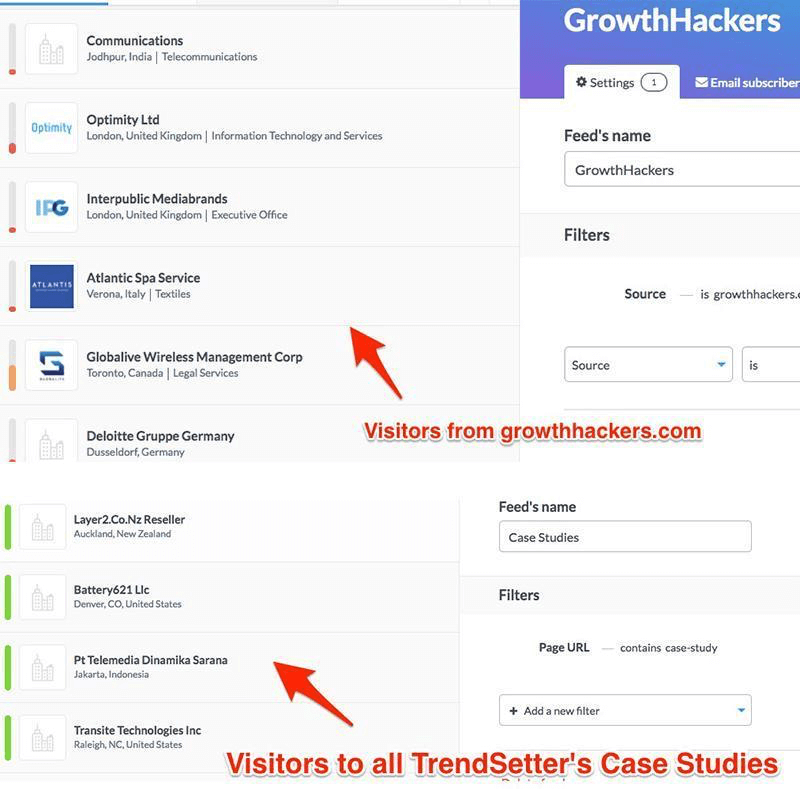
These filters (and others) make it easier to identify your most engaged visitors and pull out your most qualified leads. They can also help you break down which campaigns, referring sources, and more brought the best leads to your website.
3 Examples of Leadfeeder’s Visitor Analytics Data in Action
While we could go on and on about the ways we’ve built our visitor analytics tool for B2B marketers and salespeople, we tend to think our customers say it best.
Below, you’ll find three case studies of real Leadfeeder customers with information on how they’ve used our tool to identify more leads, learn more about their website visitors, qualify and measure leads by URL campaign, and more.
1. ROI Amplified

“Strategically, ROI Amplified has made two key discoveries about the companies that visit their site. Specifically, [CEO] Bowlby was able to confirm and fine tune his content marketing strategy thanks to data from Leadfeeder … Bowlby’s team also found that a company may view a contact page multiple times before reaching out.”
For more details on how ROI Amplified uses Leadfeeder and Zapier to create a full history of every page a company has visited before becoming a lead, check out the full case study here.
2. Triuvare

“You can figure out what percentage of your leads come directly from your social media channels. You can even take it a step further and make separate feeds for each channel. This will support your analysis from your website analytics, as it is not only the number of visitors that matters, but also whether they are useful – i.e. are you able to identify them?”
Find out more about how Triuvare is using Leadfeeder Custom Feeds to qualify content marketing leads in the full case study.
3. Red Door Interactive

“Some of the features we find most useful in Leadfeeder are … what brands and companies are coming to the website and then what are they looking at. We look at certain service areas, certain partnerships that we may have, and we have a good sense about what they might be interested in doing.”
Discover how Red Door Interactive taps into the power of website visitor identification to improve their website strategy by watching the full video case study.
Visitor Analytics Changes the Game for B2B Marketing
For some companies, traditional anonymized web analytics data can do the trick. All they need to know is how many people visited a page, came from a given campaign, or converted on a page—and that’s fine for them.
But in the B2B marketing world, that doesn’t cut it. Visitor analytics can help you identify website visitors at the account level, better understand visitors and website performance, and optimize your site for more and better leads.
Get more from your web analytics.
t’s time to turn your website traffic data into something more meaningful. Website visitor analytics enable you to identify and qualify the companies visiting your website, even when they don’t fill out a form.
Show me how



